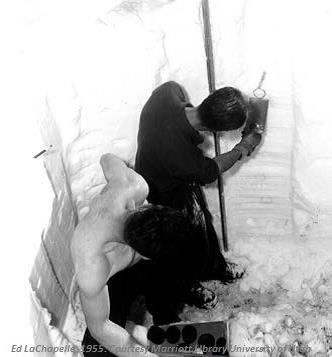Dublin Core
Title
Description
Utahns have looked to the mountains for minerals, lumber, water, and even grazing lands. But how were our mountains re-imagined into the skiing playgrounds we know today?
Alpine skiers claim that Utah has the best snow on Earth. But before people could enjoy that snow fully, there had to be a ski industry, and that took a lot of work.
Skiing in Utah dates back to the 1910s, when mailmen sometimes used skis to deliver the post. But skiing as a popular recreational activity didn’t start until the 1930s when a few outdoor enthusiasts observed the bare hills around old mining towns and dreamed of carving through fresh powder. Decades before, companies mining the Wasatch Mountains had felled the surrounding forests. When their claims went bust, they left behind ghost towns and slopes that looked very skiable.
Supporting a ski industry, however, required major infrastructure. Dreaming big, entrepreneurs took advantage of Depression-era work programs and organized the Civilian Conservation Corps – which put young men to work on public works projects – to build hard-surface roads to the slopes. Construction crews repurposed old mining equipment to build the first rope-tows and T-bar lifts to haul people up the hill. And so skiers began to replace miners in Utah’s mountains.
Skiers wanted an adrenaline fix, but didn’t necessarily want to die to get it. Avalanches in the steep canyons were a real danger, so the Forest Service got involved to protect the public. In 1952, it hired Ed LaChappelle for its Alta Research Center to survey the slopes and determine avalanche risk. LaChappelle was a Swiss physicist, glaciologist, and mountaineer, who engineered his own tools for recording snow cover and measuring – layer by layer – its water density. He used that knowledge to direct the National Guard where to fire their 75millimeter howitzer to control avalanches. LaChappelle devoted the next twenty years to making the ski slopes safer for the public.
So, while Utah may have the best snow on Earth, it doesn’t just fall that way. A lot of people put a lot of work into making it that way.
Creator
Source
Image: Ed LaChapelle takes snow layer samples, Alta, 1955. His work helped reduce avalanche risk and improve safety on Utah’s ski slopes. Marriott Library, University of Utah.
_______________
See Mette Flynt, “Canyon and Valley: The Ski Landscape of the Wasatch Front, 1915-1945,” unpublished article from research done at the University of Utah; Joseph Arave, "The Forest Service Takes to the Slopes: The Birth of Utah’s Ski Industry and the Role of the Forest Service," Utah Historical Quarterly 70, no. 4 (2002), pp. 341-356.

